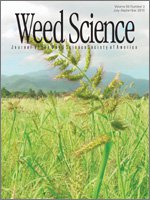The allelopathic potential of a plant has been evaluated on the basis of two indicators: specific activity, which is the specific concentration of the allelochemical to exert a half-maximum effect on a receiver plant (EC50), and total activity in a plant, which is the ratio of the concentration of an allelochemical in the producing plant to its EC50. In the present study, a new indicator, total activity in a soil, which takes into account the effects of a soil on the allelopathy activity, is proposed because allelopathic activity is affected by the presence of soils. The total activity in a soil was calculated by multiplying the “total activity in a plant” with a “soil factor.” In this calculation, we assumed simplified cases for comparison, such that the allelopathic plant materials are evenly incorporated in the soils and the allelochemicals are released from the plant materials to the soils at a constant rate. We conducted bioassay experiments in the presence and absence of soils and cited some published data to calculate the specific activities and total activities in a plant and in a soil. The results indicated that the allelopathies of buckwheat caused by ( )-catechin, Leucaena leucocephala by l-mimosine, Xanthium occidentale by trans-cinnamic acid, and Brassica parachinensis by cis-cinnamic acid were not significant in a volcanic ash soil, an alluvial soil, and a calcareous soil, but the allelopathy of sweet vernalgrass caused by coumarin and Spiraea thunbergii by cis-cinnamoyl glucosides was highly effective in those soils. The allelopathies of Juglans species caused by juglone plus juglone precursors and Mucuna pruriens by l-DOPA would depend highly on the soil types. Although some limitations exist for this approach, the total activity approach would allow for a better quantitative estimation of the allelopathic potential of plant materials in soils.
Nomenclature: Brassica parachinensis Bailey; Juglans species; Leucaena leucocephala (Lam.) de Wit; Mucuna pruriens (L.) DC. var. utilis; Spiraea thunbergii Sieb. ex Blume; Xanthium occidentale Bertol; buckwheat, Fagopyrum esculentum Moench; sweet vernalgrass, Anthoxanthum odoratum L. AOXOD; l-DOPA, 3-(3′,4′-dihydroxyphenyl)-l-alanine.





